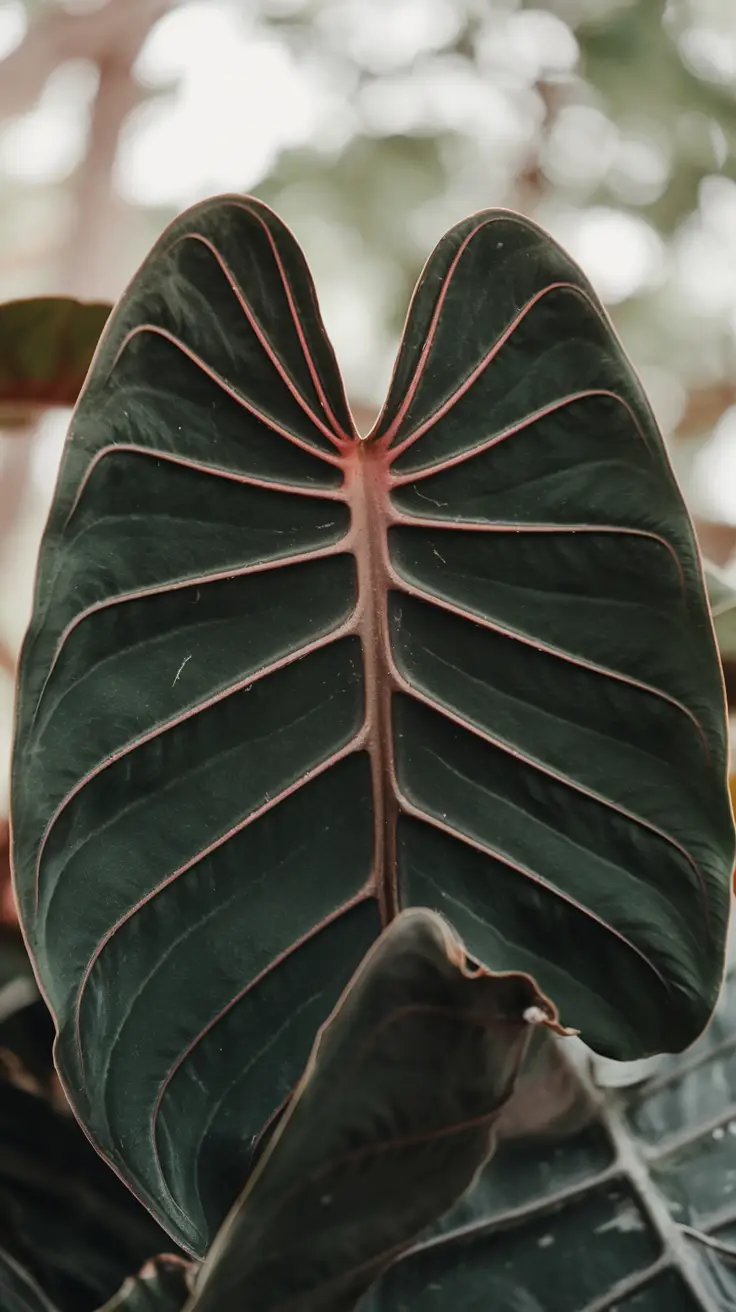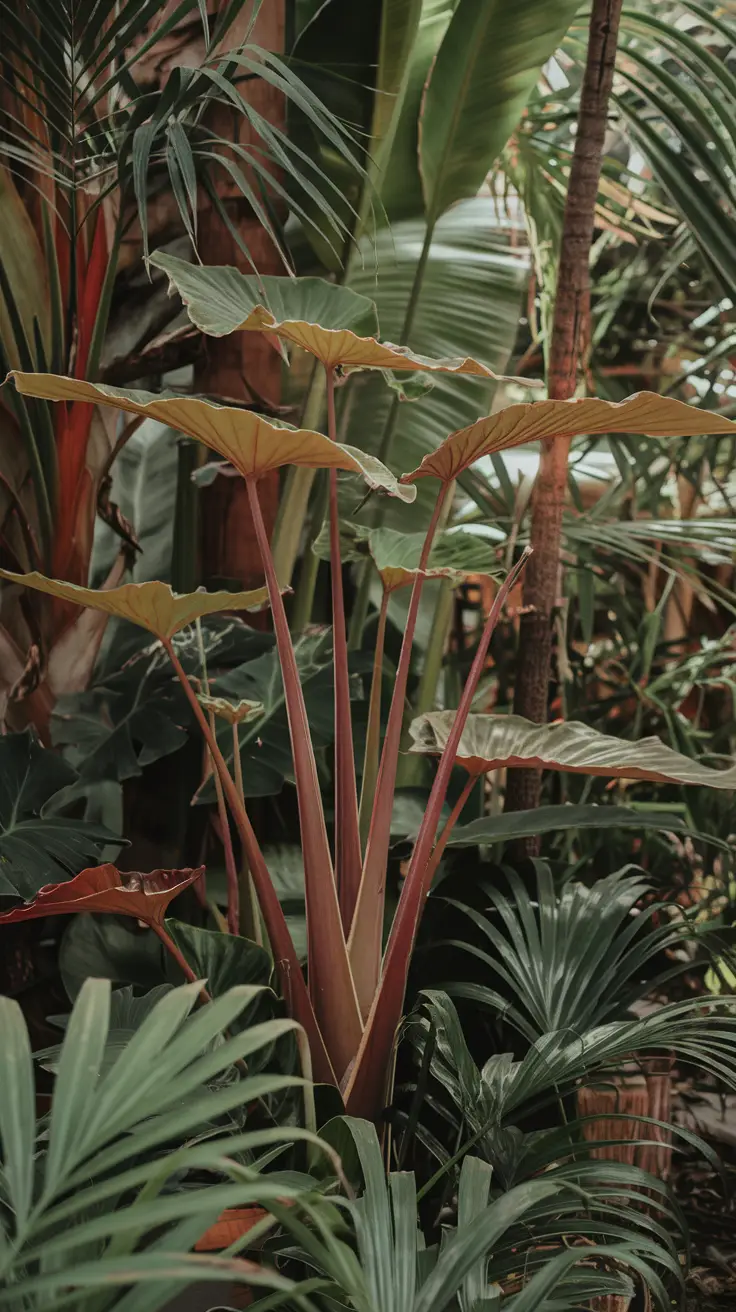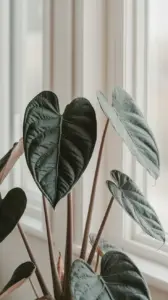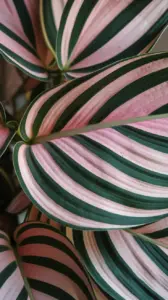Biological Features of Alocasia Wentii
Alocasia Wentii is a fascinating plant known for its dramatic appearance. This species showcases large, arrow-shaped leaves which can grow up to two feet long. The dark green foliage features prominent veins, adding to its visual appeal. Moreover, the leaves can exhibit a slight sheen, enhancing their beauty.
Growth Habit and Size
Typically, Alocasia Wentii grows as an upright plant. It can reach heights of approximately three to five feet under optimal conditions. Over time, it forms clusters, making it a stunning focal point in any garden.
Root System and Adaptability
The root system of Alocasia Wentii is extensive and fibrous. This feature allows it to adapt to various soil types, although it prefers well-draining soil. This plant thrives in warm, humid environments, making it perfect for indoor tropical settings.
Reproduction
Alocasia Wentii reproduces through rhizomes and offsets. During the growing season, it can produce flower spikes; however, these are often rare in cultivated plants. The flowers are generally small and not particularly showy, so most gardeners propagate through division.
Table of Biological Features
| Feature | Details |
|---|---|
| Common Name | Elephant Ear |
| Light Requirements | Indirect sunlight |
| Watering Needs | Moderate, keep soil moist |
| Temperature Range | 65°F to 80°F |
| Soil Preference | Well-draining, rich in organic matter |
Understanding these biological features can help you cultivate Alocasia Wentii successfully in your home or garden.

History and Cultural Significance
The Alocasia Wentii, often known for its striking leaves, has a rich cultural background. This stunning plant hails from Asia, primarily found in regions like Malaysia and Indonesia. Its unique features and adaptability have won many plant enthusiasts over. The large, arrow-shaped leaves can create an impressive display in any indoor space.
Symbolism and Usage
In many cultures, Alocasia plants symbolize prosperity and good fortune. They are often featured in homes as ornamental plants, enhancing aesthetic value. Additionally, these plants are used in various traditional practices. For example, some communities regard them as protective plants, guarding homes against negative energies.
Moreover, the Alocasia Wentii is valued for its air-purifying qualities. Many people choose to keep it indoors due to its ability to filter toxins from the air. This not only benefits health but also contributes to a serene environment.
Care and Cultivation History
The cultivation of Alocasia Wentii dates back hundreds of years. Historically, it has been propagated through division and offsets. While many appreciate its beauty, they must also understand its care requirements. It thrives in well-draining soil and needs indirect light for optimal growth. Over time, growers have developed various techniques to ensure its longevity.
- Geographical Origin: Southeast Asia, mainly Malaysia and Indonesia
- Symbolism: Represents prosperity and protection
- Air Quality: Known for its ability to purify indoor air
- Cultivation Techniques: Predominantly through division and offsets
- Light Requirements: Prefers bright, indirect sunlight

Ideal Growing Conditions for Alocasia Wentii
To thrive, Alocasia Wentii requires specific conditions. It is a tropical plant that enjoys warmth and humidity. Ensuring it has the right environment is crucial for its growth. This plant prefers temperatures ranging from 65°F to 80°F (18°C to 27°C).
The humidity level should be high, ideally between 60% and 80%. This can mimic its natural habitat, allowing the leaves to flourish. If indoor humidity is low, consider using a humidifier or placing water trays nearby. Regular misting can also help maintain the needed moisture.
Soil Requirements
A well-draining potting mix is essential for Alocasia Wentii. Use a combination of regular potting soil, perlite, and orchid bark. This mix will provide the proper aeration and drainage that the roots require. It prevents root rot, a common issue with too much moisture.
Light Preferences
When it comes to light, Alocasia Wentii thrives in bright, indirect sunlight. Direct sunlight can scorch the leaves, especially in the afternoon. Consider placing it near a north or east-facing window for optimal light exposure. If indoor lighting is insufficient, supplement with grow lights.
Watering Schedule
Watering is another crucial aspect of care. Check the top inch of the soil; if it feels dry, it’s time to water. This plant prefers consistently moist soil but not soggy conditions. Watering frequency may vary with the season, with more frequent watering in warmer months.
Fertilization Needs
Feed your Alocasia Wentii during the growing season, from spring to early fall. Use a balanced, water-soluble fertilizer every four to six weeks. Reduce feeding in winter when the plant is dormant.
| Condition | Ideal Level |
|---|---|
| Temperature | 65°F – 80°F |
| Humidity | 60% – 80% |
| Light | Bright, Indirect |
| Watering | When top inch is dry |
| Fertilization | Every 4-6 weeks during growth |
By providing optimal growing conditions, your Alocasia Wentii can thrive and bring beauty to your space.

Plant Care and Maintenance
Alocasia Wentii is a stunning plant that requires careful attention to thrive. Proper care ensures vibrant foliage and healthy growth. The key aspects of maintaining an Alocasia Wentii include watering, light preferences, humidity, and fertilization.
Watering
Watering is crucial for Alocasia Wentii. It is essential to keep the soil moist but not soggy. Overwatering may lead to root rot, while underwatering can cause the leaves to droop. Check the top inch of the soil. If it feels dry, it’s time to water. Always use well-draining soil to prevent water accumulation.
Light Preferences
This plant loves bright, indirect light. Too much direct sunlight can scorch its leaves. Conversely, too little light will stunt its growth. Ideally, place your Alocasia Wentii near a window with filtered light. A south or east-facing window is perfect for this plant.
Humidity
Humidity plays a vital role in the health of your Alocasia Wentii. This plant thrives in high humidity environments. Aim for humidity levels of 60% or higher. You can increase humidity by misting the plant regularly or using a pebble tray. Grouping with other plants can also help maintain moisture in the air.
Fertilization
Fertilizing your Alocasia Wentii encourages optimal growth. During the growing season, apply a balanced liquid fertilizer every four to six weeks. Reduce feeding in winter when the plant is dormant. Organic fertilizers can also be beneficial for enriching the soil.
Pests and Problem Prevention
Keep an eye out for pests like spider mites and aphids. Regularly inspect the underside of leaves. If you find any pests, treat them promptly with insecticidal soap or neem oil. Additionally, maintaining proper care routines helps prevent problems.
Key Maintenance Tips
- Water regularly but avoid soggy soil.
- Provide bright, indirect light for optimal growth.
- Maintain high humidity levels.
- Feed with fertilizer during the growing season.
- Watch for pests to prevent infestations.
Following these care guidelines will help your Alocasia Wentii flourish and add beauty to your indoor space.

Propagation Techniques for Alocasia Wentii
Propagation of Alocasia Wentii can be an exciting and rewarding task. Successful propagation allows you to create new plants and share them with others. To propagate this stunning plant, there are several techniques you can employ. Understanding these methods will enhance your gardening skills.
1. Division Method
The division method is one of the most commonly used techniques for propagating Alocasia Wentii. Begin by carefully removing the plant from its pot. Then, gently separate the rhizomes. Ensure that each section has at least one healthy leaf and root. This method allows the plant to grow robustly.
2. Offsets and Bulbs
Alocasia Wentii also produces offsets or bulbs, which can be detached for propagation. These smaller plants grow at the base of the main plant. Look for offsets with a few roots. Gently twist them away from the parent plant. Once detached, plant the offsets in suitable potting mix.
3. Water Propagation
Water propagation is another effective way to grow new Alocasia Wentii plants. Take a healthy leaf cutting with a portion of the stem. Place the cutting in a container filled with water, ensuring no leaves touch the water. Change the water every few days. After roots develop, transplant the cutting into soil.
4. Climate Considerations
Keep in mind that climate plays a critical role in successful propagation. Alocasia Wentii thrives in warm, humid environments. If possible, maintain temperatures between 65°F and 80°F. Humidity levels should stay high to encourage healthy root growth. Using a plastic bag or humidity dome can help retain moisture.
Conclusion
Each propagation method has its benefits and can work well for Alocasia Wentii. By understanding your plant’s needs and environmental conditions, you can ensure a successful propagation experience.
Common Problems and Solutions
Alocasia Wentii is a beautiful plant, known for its striking leaves. However, like any plant, it can face some challenges. Below are some common problems you may encounter while caring for your Alocasia Wentii, along with effective solutions.
1. Yellowing Leaves
Yellow leaves can indicate overwatering or insufficient light. Firstly, ensure that the soil is well-drained. Additionally, provide bright, indirect light to help your plant thrive.
If the yellowing persists, check for root rot. Remove the plant from its pot and inspect the roots. Trim away any brown or mushy roots, and repot in fresh soil.
2. Wilting Leaves
Wilting leaves are often a sign of underwatering. Make sure to check the soil moisture regularly. Water your Alocasia Wentii thoroughly when the top inch of soil feels dry. On the other hand, if the soil remains wet, it may lead to root rot.
3. Brown Leaf Tips
Browning tips can occur due to low humidity. Alocasia Wentii prefers a humid environment. Increase humidity levels by misting the leaves or placing a humidifier nearby. Grouping plants together can also help raise humidity.
4. Pests and Insects
Pests such as spider mites and aphids can affect your Alocasia Wentii. Inspect the leaves regularly for any signs of infestation. If you find pests, use insecticidal soap or neem oil to treat the issue.
Quick Solutions Summary
- Yellowing leaves: Check for overwatering, improve light conditions.
- Wilting leaves: Ensure proper watering and check for root rot.
- Brown leaf tips: Increase humidity with misting or a humidifier.
- Pest control: Use insecticidal soap for pests.
Preventive Measures
To avoid these common problems, maintain a proper care routine. Monitor watering needs closely, and place your Alocasia Wentii in a well-lit area. Also, provide adequate humidity to promote healthy growth.
| Problem | Causes | Solutions |
|---|---|---|
| Yellowing Leaves | Overwatering, insufficient light | Improve drainage, increase light |
| Wilting Leaves | Underwatering | Water regularly |
| Brown Leaf Tips | Low humidity | Increase humidity |
| Pests | Spider mites, aphids | Use insecticidal soap |
Seasonal Care Adjustments
Alocasia Wentii requires different care throughout the year. To ensure your plant thrives, consider making specific adjustments during each season.
Spring
In spring, increase watering as the plant awakens from dormancy. Fertilizing once a month helps promote growth. Ensure the light conditions are moderate to bright, allowing the foliage to flourish.
Summer
Summer calls for consistent moisture. Alocasia Wentii appreciates humidity, so misting is beneficial. During this time, monitor for pests and check soil moisture regularly.
Autumn
As temperatures drop in autumn, reduce watering slightly. The plant slows down, thus requiring less nourishment. Keep it in a well-lit spot but shield it from direct sunlight, which can scorch the leaves.
Winter
In winter, Alocasia Wentii enters dormancy. Water sparingly, just to keep the soil from completely drying out. Keep the ambient temperature warm and avoid placing it near drafts.
- Monitor humidity levels.
- Adjust watering frequency according to the season.
- Provide indirect light to prevent leaf scorch.
Microclimate Setup Tips
Creating the ideal microclimate for your Alocasia Wentii is vital. This tropical plant thrives in specific conditions. To enhance its growth, consider the following tips:
Light Requirements
Alocasia Wentii prefers bright, indirect light. Direct sunlight may scorch its leaves. Therefore, place it near a window with filtered light.
Humidity Levels
This plant thrives in high humidity. Aim for levels between 60% to 80%. You can achieve this by:
- Using a humidifier in the room.
- Grouping plants together to create a moisture-retaining environment.
- Placing a tray filled with water and pebbles beneath the pot.
Temperature Settings
Maintain moderate temperatures, ideally between 65°F to 80°F. Avoid drafts and sudden temperature fluctuations. Using a thermometer can help monitor these conditions effectively.
Watering Practices
Water your Alocasia Wentii when the top inch of soil feels dry. Always use room-temperature water. Overwatering can lead to root rot. Ensure the pot has adequate drainage.
Soil Selection
Opt for a well-draining potting mix. A blend of potting soil, perlite, and orchid bark works well. This mixture ensures that moisture retains without becoming soggy.
By following these setup tips, you help ensure your Alocasia Wentii flourishes in its microclimate. Happy growing!
Frequently Asked Questions
Alocasia Wentii is a remarkable plant that often prompts questions from enthusiasts. One common question is about its care requirements. This plant thrives in bright, indirect light. Direct sunlight may scorch its leaves, so provide filtered light to ensure healthy growth. Additionally, Alocasia Wentii prefers high humidity. A humidity level of 60% or higher is ideal.
Another frequent inquiry concerns watering. It’s essential to keep the soil consistently moist but not soggy. Overwatering can lead to root rot, so allow the top inch of soil to dry before watering again. Fertilizing should occur during the growing season, typically spring and summer, with a balanced liquid fertilizer.
People also wonder about repotting this plant. It’s generally recommended to repot every couple of years or when you notice roots emerging from the drainage holes. Use a well-draining potting mix to encourage healthy growth. Lastly, pests such as spider mites or aphids can sometimes affect Alocasia Wentii. Regularly inspect the leaves and treat with insecticidal soap if necessary.
Summary and Recommendations
The Alocasia Wentii is a stunning tropical plant, known for its unique leaf shape and vibrant colors. This plant thrives in high humidity and requires bright, indirect light for optimal growth. Watering should be moderate; allow the top inch of soil to dry out between waterings. Overwatering can lead to root rot, so ensure proper drainage.
Additionally, the Alocasia Wentii prefers a well-draining potting mix rich in organic matter. Regular feeding during the growing season with a balanced fertilizer can enhance its growth and foliage health.
Furthermore, consider repotting every couple of years to provide fresh soil and space for growth. This plant also benefits from regular wiping of its leaves to remove dust, promoting better photosynthesis. With the right care, the Alocasia Wentii can be a beautiful addition to any indoor space, showcasing its exotic appearance and lush greenery.






